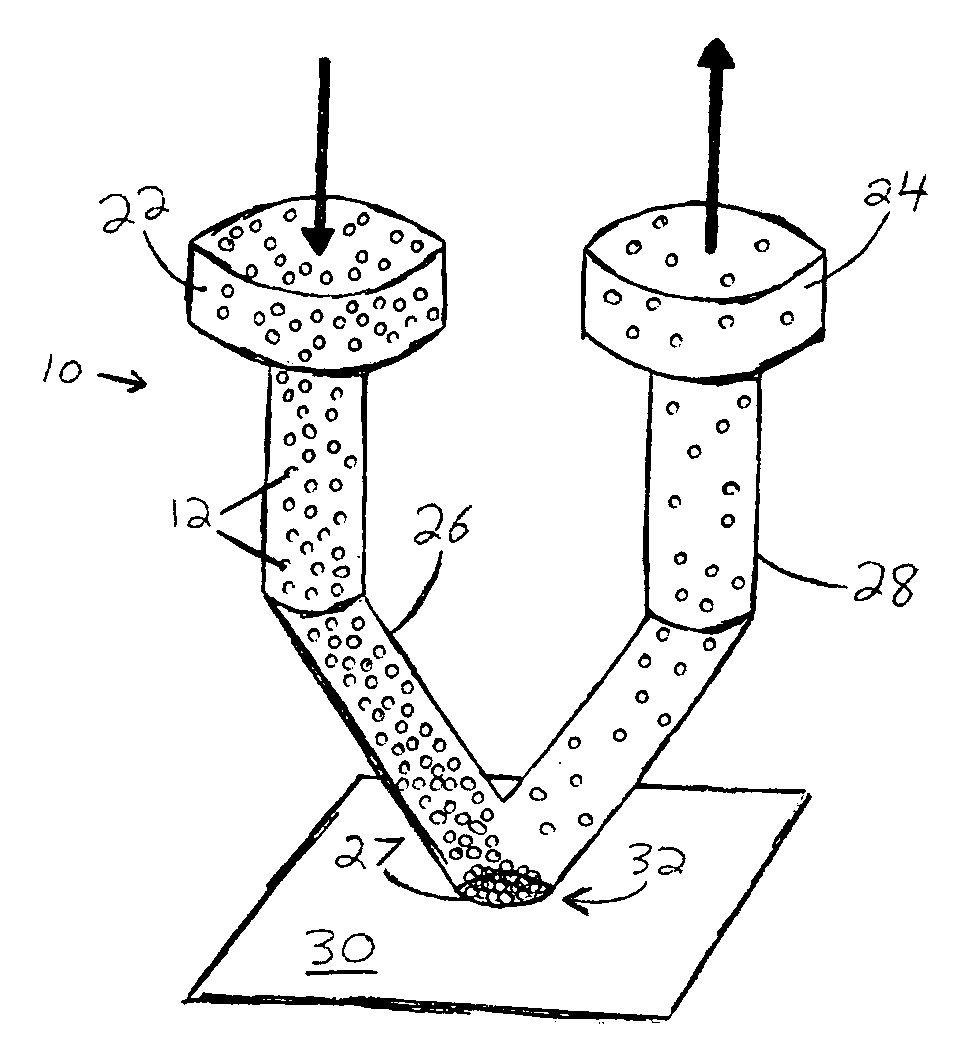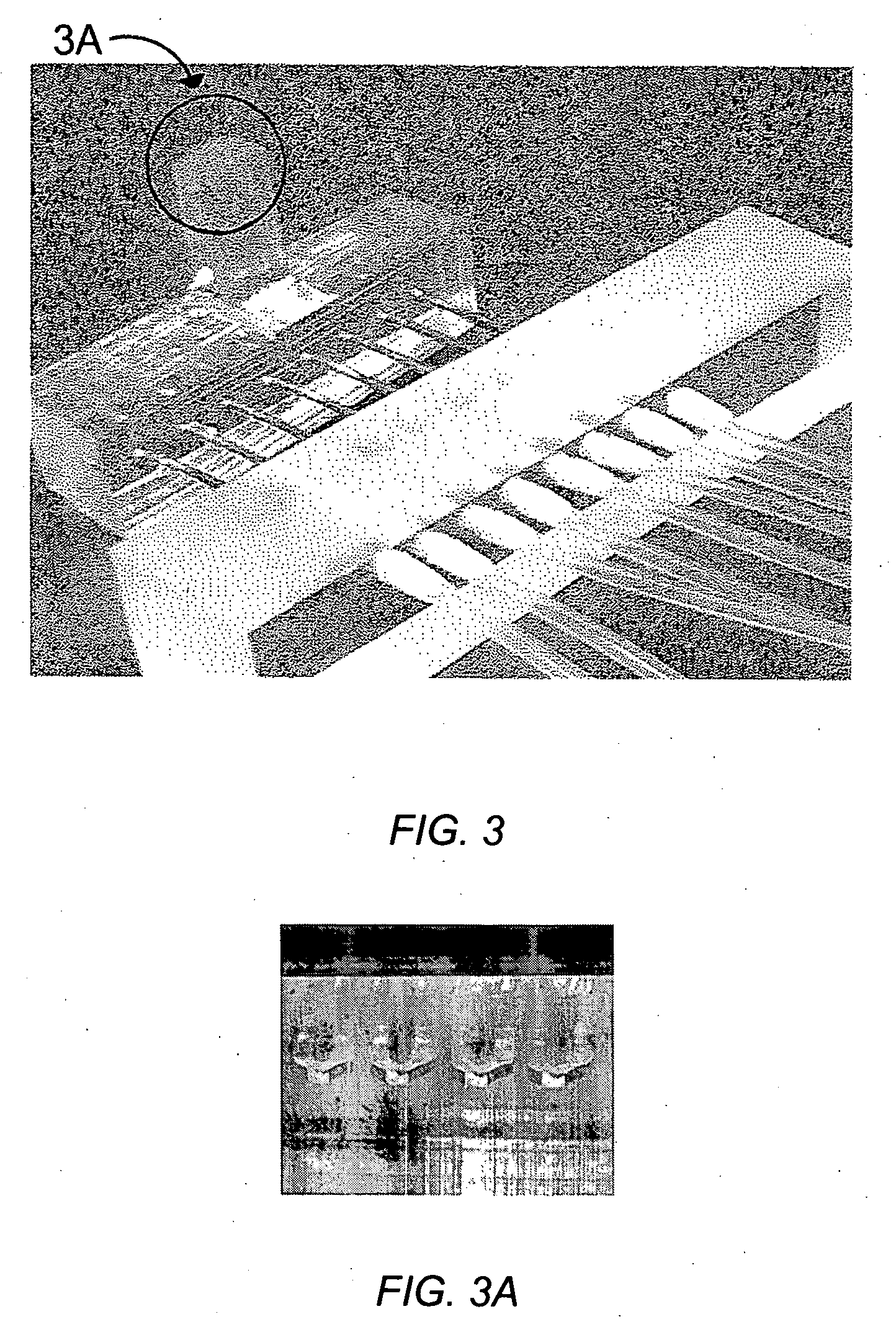Microfluidic interface for highly parallel addressing of sensing arrays
- Summary
- Abstract
- Description
- Claims
- Application Information
AI Technical Summary
Benefits of technology
Problems solved by technology
Method used
Image
Examples
example 1
Single Orifice Spotter
[0087] Deposition of Protein A was attempted with a single orifice spotter similar to that shown in FIG. 3, to validate the design concept displayed in FIG. 1. Protein A (ImmunoPure Protein A, cat #21181, Pierce Inc.) was biotinylated with Biotin (EZ-Link Sulfo-NHS-Biotin, cat #21217, Pierce Inc.) to provide specific adhesion to a surface plasmon resonance (SPR) streptavidin gold chip (8500 streptavidin affinity chip, part #4346388, AB). The protein solution was diluted to a concentration of 0.15 μg / mL in 0.1×PBS buffer (0.19 mM NaH2PO4, 0.81 mM Na2HPO4, pH 7.4 and 15 mM NaCl) and supplemented with 100 μg / mL BSA to prevent non-specific adhesion. To recirculate the solution over the chip surface, 200 μL of protein A solution was loaded into a Phynexus MicroExtractor 100 syringe pump and flowed continuously back and forth through the spotter at 75 μL / min for 1 hour. A wash step was then performed using 800 μL of 0.1×PBS with 100 μg / mL BSA. At the end, the sample...
example 2
Four Orifice Spotter
[0089] An embodiment of a four orifice spotter is shown in FIGS. 3 & 3A. ImmunoPure Protein A (Pierce, cat #21181) was prepared in PBS buffer (20 mM NaH2PO4 / Na2HPO4 pH 7.4, 150 mM NaCl) at a concentration of 5 mg / mL. The ports that address each spot were connected together using tubing so the same sample was flowed across the four spots. The spotter was mounted over a FLEXchip plain gold surface and the sample was flowed over all four spots manually using a syringe for approximately 1 hour. At the end, the spots were washed using PBS buffer and the chip was mounted according to the instructions of the manufacturer.
[0090] The protein A-adsorbed chip was inserted in the FLEXchip array instrument. The four areas where protein A was deposited were visible, so the spots could be assigned where the immobilized material is located. An example of the assigned spots is shown in FIG. 4A; the four spots labeled 1-4 correspond to immobilized protein A spots, while the rema...
example 3
Test Methods and Results
[0097] The same sample of protein A that was used in Example 2 was also used for this assay [ImmunoPure Protein A (Pierce, cat #21181) at 5 mg.mL in PBS buffer (20 mM NaH2PO4 / Na2HPO4 pH 7.4, 150 mM NaCl)]. The spotting was performed over a plain gold FLEXchip and the protein A was flowed over the chip for approximately 1 hour. At the end the spots were washed using PBS buffer and dried. The resulting spots are shown FIG. 8.
[0098] Seven of the eight protein A spots were visible after the chip was inserted into the FLEXchip array instrument. The spots were 200 microns square, roughly half the size of the spots deposited over with the four orifice spotter. A grid of 10×10 spots was assigned to enclose the eight protein A spots and the surrounding area (although the spotting pattern is a 10×10 grid, inclusion of the reference spots results in a grid of 21×11, as shown in the histogram). For reference, the protein A spots are located over the seventh column, spo...
PUM
 Login to View More
Login to View More Abstract
Description
Claims
Application Information
 Login to View More
Login to View More - R&D
- Intellectual Property
- Life Sciences
- Materials
- Tech Scout
- Unparalleled Data Quality
- Higher Quality Content
- 60% Fewer Hallucinations
Browse by: Latest US Patents, China's latest patents, Technical Efficacy Thesaurus, Application Domain, Technology Topic, Popular Technical Reports.
© 2025 PatSnap. All rights reserved.Legal|Privacy policy|Modern Slavery Act Transparency Statement|Sitemap|About US| Contact US: help@patsnap.com



